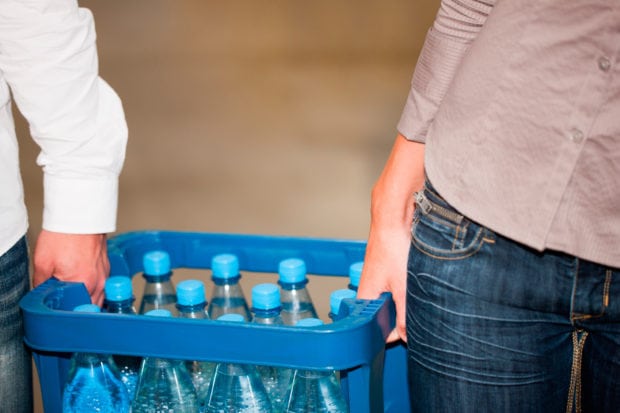Natural disasters are happening everywhere and every day. Are you prepared if something hits your home? Whether it be a flood, tornado, wildfire, or loss of power, being prepared for a disaster is what can save your life and the lives of others. Be smart and start acting today before something worse happens tomorrow.
1. Water
Red Cross says to have one gallon per person, per day. If you are being evacuated from your home, a 3-day supply is crucial, but if you are in your home to have a 2-week supply.
2. Food
Non perishable foods are a must. Your local McDonald’s will be closed, too. Canned foods work best. Easy to prepare meals like peanut butter sandwiches or on-the-go snacks such as pretzels and crackers will come in handy.
3. Flashlight
During a power outage, your cell phone’s light won’t last forever. A battery operated flashlight will do the trick to light your way. Consider packing candles, too.
4. First Aid Kit
If you don’t already own a first aid kit, you need to have one. Having a kit at home and in your car will be a lifesaver when you least expect it. Don’t forget to include at least a 7 day supply of any medications you or a family member needs. You can make your own or buy a full kit online.
5. Battery-Powered Radio
Your power’s out, your cell phone doesn’t have a signal. What do you do? Radios like these come in handy when you need to take it old-school to hear the news about your situation.
6. Extra Clothes
You don’t know how long you may be out of the house due to a complete disaster, or your water may have been turned off and you can’t wash your clothes. Having a few spare tops and bottoms are a necessity for your survival kit.

iStock
7. Batteries
Again, no power, no problem. Batteries will save the day to charge your flashlight, radio, kids toys, and more. Batteries are a must during any natural disaster.
8. Multi-Purpose Tool
This tool has it all: knife, scissors, pliers, wire-cutters, saw, screwdriver, and more. Having a multi-purpose tool is an ideal piece of equipment that can handle the outdoors, and if you end of being stuck or trapped, it can assist you on your escape.
9. Cell Phone and Chargers
I shouldn’t have to tell you this, but I put it on the list anyways. If you do lose power, a fully charged portable charger or charging phone case should do the trick.
10. Personal Hygiene Items
Staying healthy and clean should be a priority in a natural disaster since infections and sickness are all too common during these events. To do this, make sure to include hand sanitizer, a face mask, and wet wipes in your survival kit.
11. Personal Documents
If you lose your home during a disaster have these documents copied and ready to go: proof of address, birth certificates, insurance policies, passports, and more.
12. Cash
Better to have some extra cash saved when a storm strikes. If your city loses power, your credit cards are useless.
13. Emergency Contact Information
You will never be warned of an earthquake, but if you live in an area that is known to have these devastating events, an emergency contact list is crucial. Make sure to include your relatives, doctors, neighbors, and more.

iStock
14. Extra Supplies
If you have a baby or children, include extra baby supplies in your kit. If you are taking care of an elderly person, having their medical supplies or hearing aids at hand is useful as well. Don’t forget to pack your essentials as well if you wear glasses or contacts. Never forget your pets! Pack some extra food for them, too!
15. Extra Set of Home and Car Keys
Having a little extra of everything never hurt anyone. Make sure to keep a spare key for all emergency situations.
16. Manual Can Opener
With all your canned food you’ve been hoarding, you have to open them somehow. If your cans don’t have a pull-off lid, having a manual can opener will get the job done.

Photo by Luke Flynt
17. Matches
If you are stranded with no warmth, matches will be your new best friend. They can be used to start a fire in a safe location to keep from freezing during a natural disaster.
18. Umbrella
An umbrella can shelter you from rain, wind, and dirt. Use an umbrella as a makeshift roof when you’re in a storm.
19. Work Gloves
You use your hands every day. Why would you think that would be any different when there’s a natural disaster? There will be tree branches, plywood, and more you might have to get around after the storm. It is best to protect your hands from cuts and sharp edges.
20. Blanket or Sleeping Bag
A thermal blanket or sleeping bag is a must for all types of emergencies. Warmth and protection take the cake when it comes to your safety.
Optional:
- Bartering items such as food, candles, propane, and books
- Alcohol for cleaning and drinking (because you’ll need it)
- Tampons for women and neighbors
- Maps of the city you live in and the surrounding areas
- Toilet paper for more personal hygiene
For more information please visit American Red Cross
For more tips on creating your own survival kit, check out Montem Life’s “How to Make a Survival Kit: A Complete Checklist”
Feature Photo by Annie Spratt






